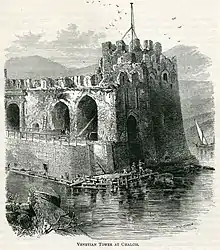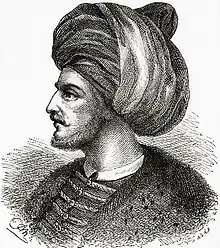Siege of Negroponte (1470)
The siege of Negroponte was fought between the forces of the Ottoman Empire, led by Sultan Mehmed II in person, and the garrison of the Venetian colony of Negroponte (Chalcis), the capital of the Venetian possession of Euboea in Central Greece. The Ottoman Sultan Mehmed II laid siege to the fortress at Negroponte. It lasted for almost a month, and despite great Ottoman casualties ended in the capture of the city and the island of Euboea by the Ottomans.
| Siege of Negroponte | |||||||
|---|---|---|---|---|---|---|---|
| Part of the First Ottoman–Venetian War | |||||||
 The Venetian-era tower of the Castle of Negroponte in the late 19th century | |||||||
| |||||||
| Belligerents | |||||||
| Ottoman Empire | Republic of Venice | ||||||
| Commanders and leaders | |||||||
|
Mehmed II Mahmud Pasha Gedik Ahmed[1] Rum Mehmed Pasha |
Paolo Erizzo Nicolò Canal Zuan Longo Zuan Tran | ||||||
| Strength | |||||||
|
70,000 men 200 small transport boats[2] |
Unknown army force under Nicolò 6,000 garrison 80 big ships[3] | ||||||
| Casualties and losses | |||||||
| unknown | Heavy | ||||||
Naval battle and siege

The Sultan started preparations to respond to the destruction caused by the Venetian navy on the islands and Enez, and to capture this island, which was considered an outpost of the Venetians. However, these preparations were kept very secret and the expedition was presented as if it would be on Rhodes. Finally, a large fleet under the command of Mahmud Pasha set out from Gallipoli in 1470, captured the island of Shira on the way, and then besieged Negroponte. Because Nicolò Canal could not prevent the Turkish fleet from entering the Negroponte canal on June 14, 1470.[4]The leader of the Venetian relief force was Nicolò Canal, known as "a man of letters rather than a fighter, a learned man readier to read books than direct the affairs of the sea."[5]

On the other hand, Sultan Mehmed himself came across Negroponte by land with a force of 70 thousand people. Sultan gathered his ships on the part of the island closest to the land and built a bridge connecting the land and the island for 3 days. In this way, cannons were transported to the island by horses, pedestrians. The sultan even crossed this bridge and set up his tent near the walls.
Now the castle was surrounded by both sea and land. Only one side of the sea route was open. Surrounding this place with ships would only be possible by passing in front of the castle. This was a very difficult and dangerous job. For this reason, as was done in Istanbul, some of the ships were transported from land to the other side of the castle and thus that road was also closed.
The first attack on the castle started from the shore. But the castle did not look like it would be taken easily. Because the towers of the castle were very high. In addition, its walls were built of chipped stones from the ground up and reinforced with lime and mortar. There was also a deep ditch dug on the beach side. Those who thought that this very fortified castle could not be taken tried to persuade the sultan to return. But the sultan and Mahmud Pasha did not pay attention to these ideas. And he placed countless mortars, cannons, rifles and springs around the castle. The castle was hit by a tremendous cannon fire. But the defenders quickly repaired the breaches and did not give up fighting. However, many parts of the walls were destroyed and a situation for attack arose.[6] At this time, the Venetian navy came to the rescue, but they were unable to enter the castle neither by land nor by sea. However, Venetian Admiral Nicolò attacked the bridge built by the Turks, but he did not achieve any success. The Venetian navy, whose courage increased with the aid force that arrived later, entered the harbor and attacked the Turkish navy. In this magnificent battle fought with cannons, rifles and arrows, the Venetians were defeated, many Venetians were killed, including Captain Zuan Longo and Zuan Tran, and their ships were sunk. Another aim of the Venetians was to land soldiers. That's why the sultan appointed Mehmed Pasha to repel those who came. In fact, Rum Mehmed Pasha took the necessary security measures against the Venetian navy. The Venetian government found this action of the navy commander Nicolò Canal unnecessary and was dismissed and sentenced to shackles because they found it wrong.
Although those on land did not take advantage of the incoming fleet, they did not lose their courage and fought very heroically. However, nothing could change the fate of the castle. After a close siege of 20 days, the attack started on the night of Wednesday, July 11, 1470, and continued until the morning, and the castle fell on Thursday, July 12.[7]
Aftermath
Because the city had refused to surrender and was taken "by the sword", as was customary, the conquering Ottoman troops were given three days to plunder, loot, and pillage. The Christian men were slaughtered, while women and children were enslaved, and Venetian soldiers were executed. More than 6,000 Venetians and Greeks died in defense of Negroponte. Only 30 known survivors made it back to Venice, consisting of 15 women, 12 children, and 3 men. There are various legends that the garrison commander, bailo Paolo Erizzo, was sawn in half. In fact, the prisoner of the siege Giovanni Maria Angiolello states that Paolo died in the first attack: "Pollo Erizzo, Bailo of the city, who was killed in the first onslaught, that is, at the defense of the Bourkos."[8] Canal was tried, fined, stripped of his rank, and exiled to Portogruaro. Most of these stories are fictitious, though the suffering of the civilians in a city taken by force was quite real. For this reasons, many places, like Athens, chose capitulation over resistance.
References
- "Gedik Ahmed Pasha".
- https://bahriyeenstitusu.org/2017/07/12/fatih-doneminde-osmanli-venedik-iliskileri-ikinci-bolum/
- https://bahriyeenstitusu.org/2017/07/12/fatih-doneminde-osmanli-venedik-iliskileri-ikinci-bolum/
- Tansel, Selahattin. Fatih Sultan Mehmed'in Siyasi ve Âskerî Faaliyetleri (PDF). p. 203.
- The Guinness Book of Naval Blunders, p. 137
- Tansel, Selahattin. Fatih Sultan Mehmed'in Siyasi ve Âskerî Faaliyetleri (PDF). p. 204.
- Tansel, Selahattin. Fatih Sultan Mehmed'in Siyasi ve Âskerî Faaliyetleri (PDF). p. 205.
- Giovan-Maria Angiolello Memoir. Pierre A. MacKay